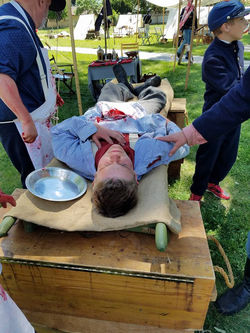II Corps Medical Services Detachment
When the war began, there were no plans in place to treat wounded or sick Union soldiers. After the Battle of Bull Run, the United States government took possession of several private hospitals in Washington, D.C., Alexandria, Virginia, and surrounding towns. Union commanders believed the war would be short and there would be no need to create a long-standing source of care for the army's medical needs. This view changed after the appointment of General George B. McClellan and the organization of the Army of the Potomac. McClellan appointed the first medical director of the army, surgeon Charles S. Tripler, on August 12, 1861. Tripler created plans to enlist regimental surgeons to travel with armies in the field, and the creation of general hospitals for the badly wounded to be taken to for recovery and further treatment.
To implement the plan, orders were issued on May 25 that each regiment must recruit one surgeon and one assistant surgeon to serve before they could be deployed for duty. These men served in the initial makeshift regimental hospitals. In 1862 William A. Hammond became surgeon general and launched a series of reforms. He founded the Army Medical Museum, and had plans for a hospital and a medical school in Washington; a central laboratory for chemical and pharmaceutical preparations was created; much more extensive recording was required from the hospitals and the surgeons.

Hammond raised the requirements for admission into the Army Medical Corps. The number of hospitals was greatly increased and he paid close attention to aeration. New surgeons were promoted to serving at the brigade level with the rank of Major. The Surgeon Majors were assigned staffs and were charged with overseeing a new brigade level hospital that could serve as an intermediary level between the regimental and general hospitals. Surgeon Majors were also charged with ensuring that regimental surgeons were in compliance with the orders issued by the Medical Director of the Army.
In the Union skilled, well-funded medical organizers took proactive action, especially in the much enlarged United States Army Medical Department, and the United States Sanitary Commission, a new private agency. Numerous other new agencies also targeted the medical and morale needs of soldiers, including the United States Christian Commission as well as smaller private agencies such as the Women's Central Association of Relief for Sick and Wounded in the Army (WCAR) founded in 1861 by Henry Whitney Bellows, and Dorothea Dix. Systematic funding appeals raised public consciousness, as well as millions of dollars. Many thousands of volunteers worked in the hospitals and rest homes, most famously poet Walt Whitman. Frederick Law Olmsted, a famous landscape architect, was the highly efficient executive director of the Sanitary Commission.
Detachment Medical Director
CPT Wayne Bechard, MS

 |  |  |  |
|---|---|---|---|
 |  |  |  |
 |  |